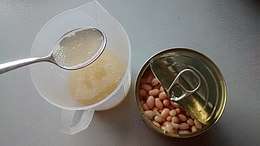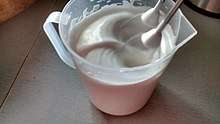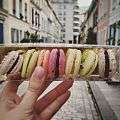Aquafaba
Aquafaba (/ˌɑːkwəˈfɑːbə/) is the viscous water in which legume seeds such as chickpeas have been cooked.

Due to its ability to mimic functional properties of egg whites in cooking, aquafaba can be used as a direct replacement for them in some cases, including meringues and marshmallows. It is especially suitable for use by people who avoid eggs, such as vegans.[1]
Uses
Aquafaba is used as a replacement for eggs and egg white. Its composition of carbohydrates, proteins, and other soluble plant solids which have migrated from the seeds to the water during cooking gives it a wide spectrum of emulsifying, foaming, binding, gelatinizing and thickening properties.
In general one medium egg white can be replaced with 30 millilitres (2 tablespoons) of aquafaba, or one medium whole egg with 45 ml (3 tbsp).[2][3]
The simplest way to obtain aquafaba is to decant the liquid from canned or boxed legumes such as white beans or chickpeas. It can be made by boiling, steaming, pressure cooking, or microwaving pulses in water.
_1.jpg)
Sweet applications include meringues, macarons, nougat, icing, ice cream, fudge, and marshmallows.[4][5][6][7]
Savory applications include baked goods, dairy substitutes, mayonnaise, cheese substitutes, batters, cocktails, and meat substitutes.[8][9][10]
Aquafaba contains about one tenth of the protein of egg whites by weight.[11] The difference in protein content may enable those who cannot properly metabolize proteins (such as phenylketonuria) to consume foods which are normally egg-based. The lower protein content makes it unsuitable for applications which rely on egg protein for structure, such as angel food cakes.[2]
The best aquafaba appears to be from chickpeas and white beans such as the Navy bean. Other legumes such as peas, lentils, soy, kidney, and black beans can be used but their slightly different compositions may require more tinkering with the concentration to work well.[2]
Origins
In December 2014, vegan musician Joël Roessel found that water from canned beans can form foams much like protein isolates and flax mucilage do.[12][13][14][15] Roessel shared his experiments on a blog and published recipes for floating island of Chaville, chocolate mousse, and meringue made from chickpea liquid to demonstrate its foaming capabilities.[16][17][18]
Around the same time, vegan food enthusiast Goose Wohlt discovered that the cooking liquid can replace egg white without the need for stabilizers. In March 2015 he published a recipe for egg-free meringue using only chickpea liquid and sugar.[19]
A few days later, a Facebook group was created to encourage development and popularize the egg substitute.[20][21]
Composition
Legume seeds, or pulses, are primarily composed of carbohydrates (starch, sugars, and fiber), proteins (albumins and globulins), and water.[22] The carbohydrates are found in greater quantities than the proteins, while the starches consist mostly of amylose and amylopectin. A typical nutritional composition of chickpeas, is listed as 19% protein, 61% carbohydrate, 6% lipids, and 14% water.[23] However, these amounts are approximate and can vary by variety.[22] During the process of cooking legume seeds, the starches in the seed are gelatinized, allowing the soluble parts of the seed to leach out into the cooking water. More material can be extracted from the seeds, if both the cooking temperature and pressure are increased, as well as extending the cooking period.[24]

Once the legumes are cooked and filtered out, the water-soluble part left is aquafaba. Comparing the final composition of a cooked seed with a raw seed shows that under normal cooking conditions, approximately 5% of the initial dry weight has been transferred to the cooking water.[25] The dry matter consisted mainly of carbohydrates (sugars, soluble and insoluble fibre) and protein. That ratio of soluble material is approximately the same ratio as found in the raw seed. However, fat and starch were not detected.[15] [26][27] A concentration of 5% dry weight to water is typical for aquafaba, but the solution can also be reduced to increase the concentration to 10% or more, depending on the application. This can be especially useful for applications where emulsification and viscosity are more important than foaming capabilities. The concentration can also be tailored to produce a more stable foam using less aquafaba by carefully filtering non-soluble material from the solution and adjusting the concentration to the application.
The first peer-reviewed publication using the term "aquafaba" was recently published by Martin Reaney's group at the University of Saskatchewan (Canada).[28][29] In this research, they have found that chickpea aquafaba from different commercial sources produces foams that vary in both properties (volume and stability of foam) and chemical composition. 1H-NMR was used to analyze the composition of aquafaba. NMR analysis revealed that the foam contained mainly polysaccharides, sucrose and protein. Protein separations by membrane filtration followed by SDS-PAGE and peptide mass fingerprinting were used to identify aquafaba proteins contributing to foaming properties. Reaney's group research showed that most of aquafaba proteins belonged to known heat soluble proteins such as late embryogenesis abundant proteins and dehydrins. Identified proteins also included heat shock protein, defensin, histone, nonspecific lipid transfer protein and superoxide dismutase. Major storage proteins provicillin and leguminin were also present. In 2015, it was theorized that the most likely agent that caused the liquid to foam was saponins.[30][31] However, the group's research has shown that aquafaba foaming property is a result of the presence of saponins, carbohydrates and protein fractions.
In general, the composition of aquafaba depend on: 1. processing methods (soaking, cooking and industrial dehydration), 2. conditions (pH, temperature, pressure and treatment duration), 3. genotype (Kabuli or Desi chickpeas), 4. additives, 5. protein concentration, and 6. carbohydrate type and concentration.[28]
Etymology
The word aquafaba is from the Latin aqua (water) and faba (bean).[32]
Gallery
 Aquafaba macarons
Aquafaba macarons Aquafaba lemon meringue pie
Aquafaba lemon meringue pie
See also
- Egg white
- Egg substitute
- Veganism
- Vegetarian cuisine
- Vegetarianism and religion
References
- Wohlt, Goose. "The Official Aquafaba Site". www.aquafaba.com. Retrieved March 22, 2016.
- Wohlt, Goose. "Aquafaba FAQ". www.aquafaba.com. Retrieved March 22, 2016.
- "The Best Vegan Egg Substitute For Baking". The Huffington Post. October 2015. Retrieved March 23, 2016.
- lindajulien (May 8, 2015). "Egg-Free, Dairy-Free, Vegan Italian Meringue Buttercream". Geeky Cakes. Retrieved March 22, 2016.
- "Vegan S'mores". olivesfordinner.com. Retrieved March 22, 2016.
- Valle, Mary (September 29, 2015). "'Aquafaba': chickpea brine is a surprisingly egg-cellent baking substitute". The Guardian. ISSN 0261-3077. Retrieved March 23, 2016.
- "13 Amazing things you can do with aquafaba". The Vegan Society. Retrieved March 22, 2016.
- "16 Unbelievable Vegan Recipes You Can Make With Canned Bean Juice (Aquafaba)". PETA. June 17, 2015. Retrieved March 22, 2016.
- "Nina's Game Changing Vegan Butter w Aquafaba". PlantePusherne. July 18, 2015. Retrieved March 22, 2016.
- "How to Use Aquafaba (AKA Chickpea Brine) for Vegan "Egg White" Cocktails". Tales of the Cocktail. December 17, 2015. Retrieved March 22, 2016.
- Wohlt, Goose. "Aquafaba Nutrition". www.aquafaba.com. Retrieved March 22, 2016.
- "La mousse végétale". Révolution végétale. December 4, 2014. Archived from the original on March 15, 2016. Retrieved March 22, 2016.
- "Mousses – Isolats de protéines". Révolution végétale. December 7, 2014. Archived from the original on February 27, 2015. Retrieved March 22, 2016.
- "Mousses – Mucilages". Révolution végétale. December 7, 2014. Archived from the original on June 25, 2015. Retrieved March 22, 2016.
- Shim, Youn Young; Mustafa, Rana; Shen, Jianheng; Ratanapariyanuch, Kornsulee; Reaney, Martin J. T. (2018). "Composition and Properties of Aquafaba: Water Recovered from Commercially Canned Chickpeas". Journal of Visualized Experiments (132): e56305. doi:10.3791/56305. PMC 5912395. PMID 29553544.
- "Île flottante végétalienne". Révolution végétale. December 7, 2014. Archived from the original on June 24, 2015. Retrieved March 22, 2016.
- "Mousse au chocolat". Révolution végétale. December 9, 2014. Archived from the original on April 4, 2015. Retrieved March 22, 2016.
- "Meringue végétalienne - Révolution végétale". December 4, 2014. Archived from the original on March 28, 2015. Retrieved March 22, 2016.
- Olkan Elijah (February 22, 2015), Le Défi FUDA - BONUS #1 Mission Pois Chiches, retrieved March 22, 2016
- wohlt, goose. "Aquafaba History". www.aquafaba.com. Archived from the original on August 29, 2018. Retrieved March 22, 2016.
- "One solution for all egg-free baking needs". philly-archives. Retrieved March 23, 2016.
- Rachwa-Rosiak, Danuta; Nebesny, Ewa; Budryn, Grażyna (January 1, 2015). "Chickpeas—composition, nutritional value, health benefits, application to bread and snacks: a review". Critical Reviews in Food Science and Nutrition. 55 (8): 1137–1145. doi:10.1080/10408398.2012.687418. ISSN 1549-7852. PMID 24915347.
- "Nutrition Facts and Analysis for Chickpeas (garbanzo beans, bengal gram), mature seeds, raw". SELFNutritionData. Retrieved March 23, 2016.
- Sayar, Sedat; Turhan, Mahir; Köksel, Hamit (December 1, 2003). "Application of unreacted-core model to in situ gelatinization of chickpea starch". Journal of Food Engineering. 60 (4): 349–356. doi:10.1016/S0260-8774(03)00057-8.
- Alajaji, Saleh A.; El-Adawy, Tarek A. (2006). "Nutritional composition of chickpea (Cicer arietinum L.) as affected by microwave cooking and other traditional cooking methods" (PDF). Journal of Food Composition and Analysis. 19 (8): 806–812. doi:10.1016/j.jfca.2006.03.015. Archived from the original (PDF) on May 28, 2016.
- Stantiall, S. E.; Dale, K. J.; Calizo, F. S.; Serventi, L. (2018). "Application of pulses cooking water as functional ingredients: the foaming and gelling abilities". European Food Research and Technology. 244 (244): 97–104. doi:10.1007/s00217-017-2943-x.
- "Aquafaba, what is its chemical composition?". www.friekaker.no. January 28, 2016. Retrieved March 23, 2016.
- Youn Young Shim; Rana Mustafa; Jianheng Shen; Kornsulee Ratanapariyanuch; Martin J. T. Reaney (2018). "Composition and Properties of Aquafaba: Water Recovered from Commercially Canned Chickpeas". Journal of Visualized Experiments (132): e56305. doi:10.3791/56305. PMC 5912395. PMID 29553544.
- "Dr. Reaney". teamphat.usask.ca. Retrieved February 16, 2018.
- "Composition des liquides de trempage des végétaux". Révolution végétale. January 25, 2015. Retrieved February 8, 2016.
- Hartke, Kristen (October 5, 2015). "Trust us. You can use the liquid from a can of beans to make dessert". The Washington Post. ISSN 0190-8286. Retrieved March 23, 2016.
- "aquafaba". Oxford English Dictionary (3rd ed.). Oxford University Press. September 2005. (Subscription or UK public library membership required.)
| Look up aquafaba in Wiktionary, the free dictionary. |